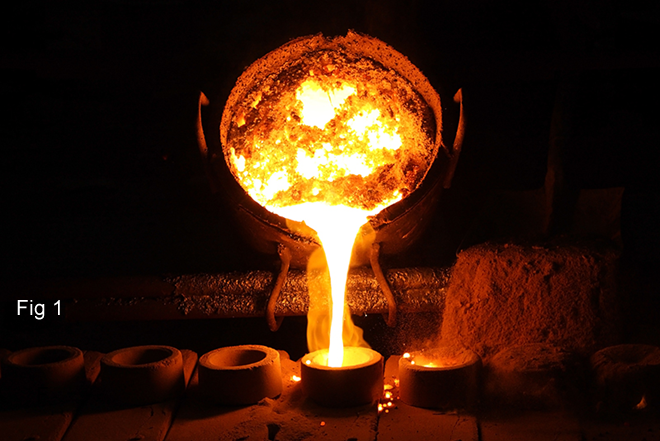Foundry
A foundry is a factory that produces metal castings. Metals are cast into shapes by melting them into a liquid, pouring the metal in a mold, and removing the mold material or casting after the metal has solidified as it cools. The most common metals processed are aluminium and cast iron. However, other metals, such as bronze, brass, steel, magnesium, and zinc, are also used to produce castings in foundries. In this process, parts of desired shapes and sizes can be formed.
Foundry involves the following Process:
Casting: involves pouring liquid metal into a mold, which contains a hollow cavity of the desired shape, and then allowing it to cool and solidify. The solidified part is also known as a casting, which is ejected or broken out of the mold to complete the process. Casting is most often used for making complex shapes that would be difficult or uneconomical to make by other methods. Melting: Furnaces is used to melt the materials in it. Row material, external scrap, internal scrap, and alloying elements or ferroalloys are used to charge the furnace. External scrap is material from other forming processes such as punching, forging, or machining. Internal scrap consists of gates, risers, defective castings, and others (fig 1)

The process includes melting the charge, refining the melt, adjusting the melt chemistry and tapping into a transport vessel. Refining is used to remove deleterious gases and elements from the molten metal to avoid casting defects. Material is added during the melting process to bring the final chemistry within a specific range specified by industry and internal standards. Certain fluxes may be used to separate the metal from impurities in form a slag. Degassers are used to remove dissolved gas from metals that readily dissolve certain gasses.
Furnace
Several specialised furnaces are used to melt the metals as following:
Iron: Cupola, induction furnace, or EAF (electric arc furnace).
Steel: EAF or induction furnace.
Bronze or Brass: Crucible furnaces or induction furnaces.
Aluminium: electric resistance or gas heated crucible furnaces or reverberatory furnaces.
Degassing
Degassing is a process that may be required to reduce the amount of hydrogen present in a batch of molten metal. Gases can form in metal castings in one of two ways:
- By physical entrapment during the casting process
- By chemical reaction in the cast material.
Hydrogen is a common contaminant for most cast metals. It forms as a result of material reactions or from water vapour or machine lubricants. If the hydrogen concentration in the melt is too high, the resulting casting will be porous; the hydrogen will exit the molten solution, leaving minuscule air pockets, as the metal cools and solidifies. Porosity often seriously deteriorates the mechanical properties of the metal.
An efficient way of removing hydrogen from the melt is to bubble a dry, insoluble gas through the melt by purging or agitation. When the bubbles go up in the melt, they catch the dissolved hydrogen and bring it to the surface. Chlorine, nitrogen, helium and argon are often used to degas non-ferrous metals. Carbon monoxide is typically used for iron and steel.
There are many other processes in the foundry industries such as Mold making, Pouring, Shakeout, Degating, Surface cleaning and Finishing.

